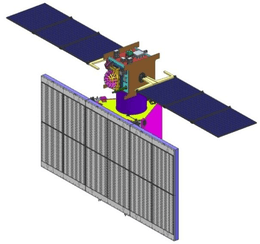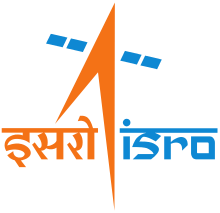RISAT
RISAT (Radar Imaging Satellite) is a series of Indian radar imaging reconnaissance satellites built by ISRO. They provide all-weather surveillance using synthetic aperture radars (SAR).
 | |
| Manufacturer | ISRO |
|---|---|
| Country of origin | India |
| Operator | ISRO |
| Applications | Earth imaging SAR |
| Specifications | |
| Launch mass | 400 kg (880 lb)-2,000 kg (4,400 lb) |
| Power | Up to 2200 kW |
| Batteries | Solar |
| Equipment | Synthetic Aperture Radar |
| Regime | SSO |
| Dimensions | |
| Production | |
| Status | Operational |
| Launched | 4 |
| Operational | 3 |
| Lost | 1 |
| Maiden launch | RISAT-2 (2009) |
| Last launch | RISAT-2BR1 (2019) |
The RISAT series are the first all-weather earth observation satellites from ISRO. Previous Indian observation satellites relied primarily on optical and spectral sensors which were hampered by cloud cover.
After the November 26, 2008 Mumbai attacks, the launch plan was modified to launch RISAT-2 before RISAT-1, since the indigenous C-band SAR to be used for RISAT-1 was not ready. RISAT-2 used an Israel Aerospace Industries (IAI) X-band SAR sensor similar to the one employed on TecSAR.
Satellites
RISAT 2
RISAT-2 was the first of the RISAT series to reach orbit.[1] It was launched successfully on April 20, 2009 at 0015 hours GMT by a PSLV rocket. The 300-kg satellite was built by ISRO using a X-band SAR manufactured by IAI.[2][3][4]
This satellite was fast tracked in the aftermath of the 2008 Mumbai attacks.[5] The satellite will be used for border surveillance, to deter insurgent infiltration and for anti-terrorist operations.[6] It is likely to be placed under the Aerospace Command of the Indian Air Force.[7]
No details of the technical specifications of RISAT-2 have been published. However, it is likely to have a spatial resolution of about a metre or so. Ship detection algorithms for radar satellites of this class are well-known and available. The satellite also has applications in the area of disaster management and agriculture-related activities.[6]
RISAT 1
RISAT-1 was an indigenously developed radar imaging satellite successfully launched by a PSLV-XL rocket on April 26, 2012 from Satish Dhawan Space Centre, Shriharikota. RISAT-1 was postponed in order to prioritize the building and launch of RISAT-2.[5][8][9][10]
The features of RISAT-1 include:
- 160 x 4 Mbit/s data handling system
- 50 Newton-meter-second reaction wheels
- SAR antenna deployment mechanism
- Phased array antenna with dual polarisation
RISAT 2B
RISAT-2B is an indigenously developed Synthetic Aperture Radar (SAR) imaging satellite operating in X Band with 3.6 m radial rib antenna.[11] It was launched by PSLV C46 (Core Alone) on 22 May 2019 at 0000 (UTC) from First Launch Pad of SDSC (SHAR).[12]
The satellite has the capability operate in different modes including Very High Resolution RADAR imaging modes of 1m × 0.5m resolution and 0.5m × 0.3m resolution. RISAT-2B is placed in an inclined orbit for better revisit rates over area of interest. Being Radar Imaging satellite, it can image during day / night / all weather conditions. The Satellite will be utilized for high resolution spot imaging of locations of interest.[13][14]
RISAT 2BR1
RISAT-2BR1 is an Indian radar reconnaissance satellite that is part of India's RISAT programme and the fourth satellite in the series. It is built by Indian Space Research Organisation (ISRO). It was launched on 11 December 2019 at 3:25 PM IST on board PSLV rocket from Satish Dhawan Space Centre.[16]
The satellite has resolution of 0.35 meters by which two objects separated by distance of 0.35 metres can be distinctly identified. The mission duration is planned to be 5 years. It is the 50th launch of Polar Satellite Launch Vehicle and 75th launch from Satish Dhawan Space Centre.[17][18]
Launch schedule
| Designation | Resolution (in meters) | COSPAR ID | NORAD ID | Power | Launch date, Time (UTC) | Launch mass | Launch vehicle | Launch site | Remarks |
|---|---|---|---|---|---|---|---|---|---|
| RISAT-2 | Unknown | 2009-019A | 34807 | 20 April 2009, 01:15 | 300 kg (660 lb) | PSLV-CA C12 | SLP, SDSC | Equipped with Israeli SAR similar to that in TecSAR. | |
| RISAT-1 | 1 | 2012-017A | 38248 | 2200 kW | 26 April 2012, 00:17 | 1,858 kg (4,096 lb) | PSLV-XL C19 | FLP, SDSC | Equipped with indigenous SAR. |
| RISAT-2B | 0.5 x 0.3 | 2019-028A | 44233 | 22 May 2019, 00:00 | 615 kg (1,356 lb) | PSLV-CA C46 | FLP, SDSC | ||
| RISAT-2BR1 | 0.35 | 2019-089F | 44857 | 11 December 2019, 09:55 | 628 kg (1,385 lb) | PSLV-QL C48 | FLP, SDSC | ||
| RISAT-2BR2 | TBD | TBD | 2020 (Planned) | PSLV C49 | SDSC | ||||
| RISAT-1A | TBD | TBD | 2020 (Planned) | PSLV C50 | SDSC |
References
- "Risat-2 Launched". ASM. Archived from the original on 2009-04-24. Retrieved 2009-03-22.
- "India to launch Israel-backed satellite". CNN. 2009-03-21. Retrieved 2009-03-22.
- http://www.iai.co.il
- "India set to launch imaging satellite with Israeli support". PTI. 20 Mar 2009. Retrieved 2009-03-22.
- "The difference between Risat-1 and Risat-2". ASM. Archived from the original on 2010-09-12. Retrieved 2009-03-25.
- "India to launch spy satellite on April 20". The Times Of India. 2009-04-08.
- "Archived copy". Archived from the original on 2009-02-16. Retrieved 2009-04-06.CS1 maint: archived copy as title (link)
- "ISRO's New Satellite Could See Through Even Cloudy Sky". Indo Daily. November 7, 2008. Archived from the original on May 20, 2011. Retrieved 2009-03-21.
- Launch Info Archived 2009-05-22 at the Wayback Machine
- "Earth Observation System". ISRO. Archived from the original on October 10, 2008. Retrieved 2009-03-21.
- "RISAT-2B: Radial Rib Antenna - ISRO". www.isro.gov.in. Retrieved 2019-07-04.
- "PSLV-C46 successfully launches RISAT-2B - ISRO". www.isro.gov.in. Retrieved 2019-07-04.
- "Rajya Sabha Unstarred Question No. 1531 : Earth Observation satellite RISAT-2B" (PDF). 4 July 2019. Retrieved 4 July 2019.
- "Earth Observation Satellite RISAT-2B". pib.nic.in. Retrieved 2019-07-04.
- "PSLV-C46/RISAT-2B press kit" (PDF). 17 May 2019. Retrieved 4 July 2019.
- "ISRO's RISAT-2BR1, 9 Other Foreign Satellites Blast Off from Sriharikota". www-news18-com.cdn.ampproject.org. Retrieved 2019-12-11.
- Singh, Surendra (December 3, 2019). "Isro to launch another 'eye in the sky' Risat-2BR1 on December 11, will help boost border surveillance". The Times of India. Retrieved 2019-12-11.
- IANS (2019-12-03). "ISRO to launch border surveillance satellite Risat-2BR1 on Dec 11". Business Standard India. Retrieved 2019-12-11.
